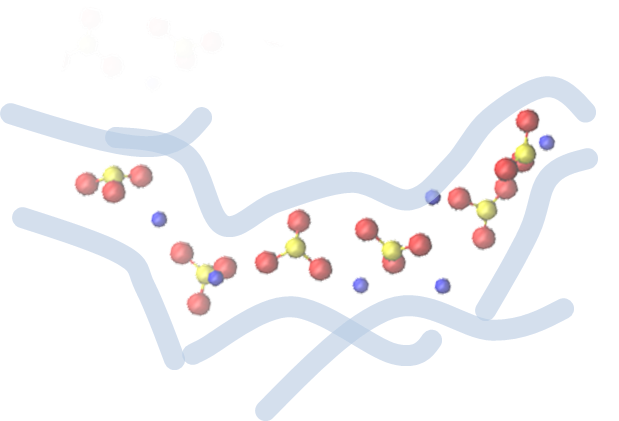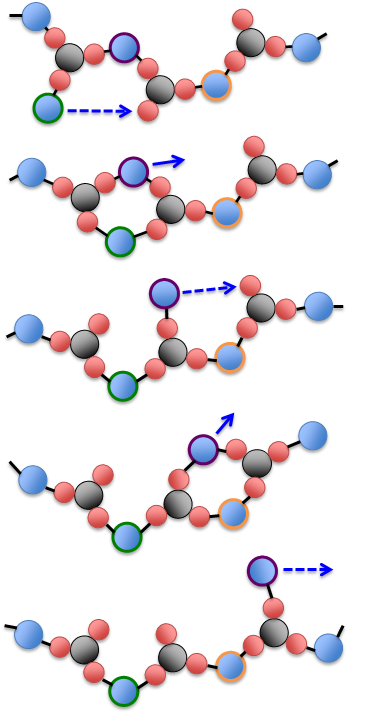
Effect of nanofillers on the conductivity of solid polymer electrolytes Solid polymer electrolytes (SPEs) consist of a polymer host with dissolved lithium salts.
Li+ ions transport through the polymer matrix via a combination of hopping and segmental motion of PEO.
These electrolytes can replace the volatile, toxic and flammable liquid electrolytes currently used in commercial Li-ion batteries.
SPEs reduce dendrite formation and enable use of high energy density lithium metal anode. SPEs have applications in a wide range
of devices including electronics, hybrid electric vehicles, medical implant devices, and for storing power generated
from alternate energy devices such as solar cells.
Polymer Electrolytes  Molecular dynamics is a powerful tool for probing properties of materials that are difficult to study through
experimental techniques.
One such phenomenon is ion conduction in these materials occurs through opportunistic
hopping from one solvation site to another in the polymer host. We use atomistic molecular dynamics to probe ion behaviour
in a PEO-based ionomer.
Molecular dynamics is a powerful tool for probing properties of materials that are difficult to study through
experimental techniques.
One such phenomenon is ion conduction in these materials occurs through opportunistic
hopping from one solvation site to another in the polymer host. We use atomistic molecular dynamics to probe ion behaviour
in a PEO-based ionomer.
 In particular, we I working towards identifying the conductions upon which a new "super-ionic"
conduction mechanism utilizing ion aggregations.
We are using also coarse-grained technique to understand the behaviour of ion aggregation. In our approach
polymer is implicitly represented, such that our simulation has only ions. There ions interact as if polymer were present.
In particular, we I working towards identifying the conductions upon which a new "super-ionic"
conduction mechanism utilizing ion aggregations.
We are using also coarse-grained technique to understand the behaviour of ion aggregation. In our approach
polymer is implicitly represented, such that our simulation has only ions. There ions interact as if polymer were present.We find from our simulation that our aggregates are string-like random-walks of ions. In general, ions have two oppositely charged neighbours but there are instances of ions which have an extra, third neighbour. We find that these extra ions can "pinball"charge down an ion chain, transfering charge a greater distance than the motion of any particular ion. This may be the mechanism behind the superionic phenomenon found in atomistic simulations. The Structure of Plant Cell Wall & Cellulose Plant cell walls play vital roles in plant morphogenesis, cell expansion and intercellular transportation.
To understand the biological functions better, we systematically investigate the structures and dynamics inside the cell wall.
Structurally, cell wall is composed of several biopolymers, including cellulose (~30%), hemicelluloses (~30%) and pectins (~40%).
The biopolymers interact and compose a thin cell wall, which provides the mechanical strength of plant.
We also use simulation techniques (both atomistic and coarse-grained) to develop a better understanding of each structural component and aiming to build a model that describes the load-bearing network of primary cell wall. By increasing our fundamental knowledge of the physical structure of cell walls, we provide a scientific basis for improved methods of converting biomass into transportation fuels.
Many important features of plant cell walls are at meso-scale (10 nm - 1μm) and chemical analysis using existing experimental tools is challenging. We proposed a coarse-grained model of primary plant cell wall that incorporates relevant physical wall components (for example cellulose microfibrils, hemicellulose in different configurations and pectin/water gels), yet is coarse enough to evaluate mechanical properties. The usefulness of such a model is to learn the controlling factors for experimental observations. This model can return the interaction strengths required to match mechanical data.
For more information visit www.lignocellulose.org Computational Modeling of Electrochemical Interfaces In the design and functionality of devices such as proton exchange membrane fuel cells (PEMFCs), the interaction between the electrode and electrolyte plays a critical role. It is at the electrode surface that the desired reactions, such as the oxygen reduction reaction (ORR), take place. Transport of reactive species to the surface and the overall reactions kinetics are greatly affected by the interfacial structure. However, there has been little research conducted in understanding the structure of this interface, and how it reacts to different environmental conditions. In our group, we are combining classical molecular dynamics (MD) simulations using a reactive force-field (Charge Optimized Many Body COMB potentials) with quantum mechanical (QM) calculations to elucidate this structure. The goal is to design a new simulation technique capable of analyzing the important phenomena at electrochemical interfaces, such as chemical reactions, potential distribution and charge polarizability. With this understanding, reactions such as the ORR in PEMFCs can be analyzed more completely and experimental conditions can be suggested from a more fundamental standpoint. This research project has been supported by the National Science Foundation and is conducted in collaboration with the Mike Janik Research Groupand Susan Sinnott Research Group.
Biomimetic Desalination Membranes Neutron scattering is used in conjunction with coarse-grained molecular dynamics to study the properties of these novel membranes. Neutron scattering can measure amphiphile block dimensions, probe polymer-protein aggregation kinetics, and corroborate coarse-grained simulation results.
|
||||||
|
Website designed by Kokonad Sinha © Janna Maranas Research Group Department of Chemical Engineering, The Pennsylvania State University |
||||||